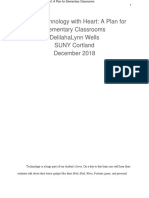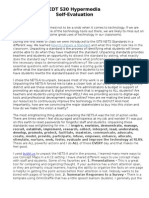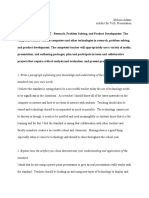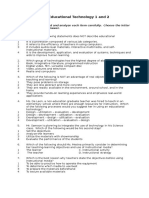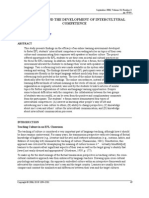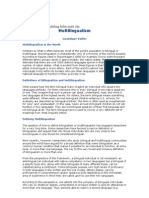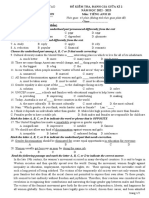Teaching The Correct Use of Omissive Apostrophes in Year 4 Using Multimedia Software
Teaching The Correct Use of Omissive Apostrophes in Year 4 Using Multimedia Software
Uploaded by
api-27788847Copyright:
Available Formats
Teaching The Correct Use of Omissive Apostrophes in Year 4 Using Multimedia Software
Teaching The Correct Use of Omissive Apostrophes in Year 4 Using Multimedia Software
Uploaded by
api-27788847Original Title
Copyright
Available Formats
Share this document
Did you find this document useful?
Is this content inappropriate?
Copyright:
Available Formats
Teaching The Correct Use of Omissive Apostrophes in Year 4 Using Multimedia Software
Teaching The Correct Use of Omissive Apostrophes in Year 4 Using Multimedia Software
Uploaded by
api-27788847Copyright:
Available Formats
Teaching the correct use of omissive
apostrophes in Year 4 using
multimedia software
Over time she has discovered the best way to improve your
The school
ICT skills is to use it for something which requires more skill
Situated in a residential area north of a major northern city than you currently possess.
this Voluntary Aided Church of England school provides
schooling from reception to Year 4. On entry pupils have "You nearly always find that if you have a project,
good communication and social skills. By the time pupils something meaningful, that’s where you learn. In other
leave school, at the age of nine, attainment in English, words, if you’ve got a school magazine to produce, you learn
mathematics, science, music and information technology is the skills that are necessary to do that. Learning skills
well above average. without then having the need to put them into practice is a
waste of time."
The teacher
The pupils
The teacher has been teaching at the school for ten years and
has taught Years 2 and 3 in addition to Year 4. As ICT co- Before the project began the pupils had been carrying out
ordinator she has been instrumental in moving ICT forward work on using apostrophes correctly. The teacher had used a
within the school. She enjoys a close working relationship number of different strategies which did not use ICT to teach
with colleagues and values the contacts made while this aspect of word and sentence level work but found, after
attending in-service courses. She comments on the fact that: testing, that more than half the class had failed to
understand the use of apostrophe especially when used for
"When attending a course I like to come back inspired with omissions or contractions. Given the amount of input which
new ideas to put into practice." had taken place (for example whole class teaching,
individual worksheets, homework and even a demonstration
When using ICT she is always conscious of the links that are using a feather duster to ‘tickle out’ letters) the teacher was
required into other subject areas and never teaches ICT in rather surprised at the test results and keen to make use of
isolation. She is keen to point out that: ICT to try and improve the children’s understanding. Could
"Although I favour using the computer, unless I have ICT help them move from ‘will’nt’ to won’t?
planned to use it to meet specific learning objectives you
will probably find my computer switched off." The aim of the project
This project aimed to move pupils’ understanding forward in
Alongside using ICT in the curriculum she makes good use the use of the apostrophe. The teacher was keen to involve
of the technology for planning, recording, reporting and all the children in the use of ICT and not just those who
creating resources. Having access to the Internet at home has were struggling with the correct usage. It was decided that
proved invaluable in literacy hour preparation. She is in addition to using the ICT to improve apostrophe usage a
enthusiastic about sharing resources across the Internet and program would be used which would also stretch their ICT
hopes, in time, this will result in more creative and exciting skills and contribute to their IT capability. Many of the
teaching. children have computers at home and as a consequence some
pupils had high levels of ICT skills.
Effective pedagogy using ICT in literacy and numeracy in primary schools
2 Ways forward with ICT: Developing literacy
was made clear to the children that although the final
product would appear on the computer the majority of the
work would take place away from the computer. This did not
in anyway dampen their enthusiasm.
How the teacher developed the
project
The teacher used a brainstorming session to get the project
underway. The children were asked to come up with ideas on
how they might teach the use of apostrophes to other pupils.
Initially they could only come up with "test them". Further
discussion led by the teacher produced more useful ideas
Screen from the ‘Apostrophe Stack’. with the children agreeing that if they could establish some
rules and examples this might work. Discussions also took
place about presentation with the children deciding they
The teacher’s choices wanted a ‘character’ who appeared when help was
The teacher had used a multimedia program in the past to requested. Many other ideas were forthcoming, some
support a project on Ancient Greece. She had been impressed discarded, others making their way into the final
with the work the children contributed to the project both at presentation.
and away from the computer. However, this program had
proved difficult for some of the children to use and not all
were able to take part in the computer activity because of
the ICT skills demanded by the program. With its ease of use
a newer multimedia program renewed her enthusiasm. She
was convinced that these pupils would rise to the challenge;
especially a challenge where there would be a wider
audience and purpose for their work.
Given the disappointing results of their initial apostrophe
test the teacher thought they could both enhance their ICT
skills and improve their understanding of the apostrophe by
creating a multimedia presentation to teach other children
about correct apostrophe usage. She thought that getting Screen showing the ‘character’ competition winners.
them to identify how to teach aspects of correct usage would
develop their awareness and understanding of how to use The teacher organised a ‘character’ competition where all the
apostrophes correctly themselves. pupils submitted a drawing; the drawings were all displayed
with pupils voting for their top three. This enabled the
The teacher chose to use HyperStudio, a multimedia program whole class to work on the project at the same time and
which allows pupils to mix text, graphics, sound and video increased the motivation for the task as well as supplying a
so that the pupils could consider how to communicate their deadline for completion. In additional sessions children
ideas effectively. As the teacher had never used this package worked on colour schemes, and planned the layout of the
before she was enthusiastic about learning alongside the ‘stack’ (the series of multimedia pages which made up the
pupils. presentation). They also agreed on what the rules might be
for omissive apostrophes (e.g. it’s and didn’t but not
It was explained to the children that they were to produce a children’s which is an example of a possessive apostrophe)
multimedia presentation which could be used by other and came up with hints, tips and examples of use.
children to help them understand the use of apostrophes. It The session with the children where they finally decided on
Effective pedagogy using ICT in literacy and numeracy in primary schools
Ways forward with ICT: Developing literacy 3
the rules is worth particular consideration. It involved the teacher was motivated to use this program because she
children in word level work distinguishing uses of the wanted to improve her own ICT skills. Learning with the
apostrophe as well as sentence level work identifying children is something she enjoys and felt this was an
patterns in how apostrophes were used. In pairs the children excellent opportunity to develop her own ICT skills.
were given a list showing the original two words followed by
the contraction e.g. your are - you’re. They were asked to use The teacher used ICT as a vehicle to encourage the children
colour pencils to highlight groups which they thought were to work as a team. Although the stack was considered by the
similar. Many children looked at the number of missing children as the final result, for the teacher it was the
letters and created a grouping this way. Others came up with thinking that had gone into establishing the rules, agreeing
more sophisticated patterns. Once they had finished, a whole the examples, hints and tips and working collectively as a
class discussion took place on what the groups had found class that was important. In moving their understanding of
and finally a consensus was reached which everyone agreed omissive apostrophes forward, the work that had taken place
to and understood. away from the computer was more important than what had
actually been achieved using the computer.
As the project unfolded the teacher became increasingly
aware of how complex the teaching of this particular aspect
of word and sentence level work was. The teacher was
impressed with the quality of discussion which took place in
the whole class sessions and with the effort the children put
into trying to make meaning for other students. As with her
project on Ancient Greece she felt it was the creation of
multimedia and the preparation work which that entailed
which had benefited the children’s learning and not just the
use of the technology. The teacher is not convinced that the
use of the completed stack would necessarily move other
Screen showing some of the pupils’ rules. children’s understanding of apostrophes forward, though the
children could have used it to try it out on their peers.
The teacher thinks that encouraging the children to
formulate their own rules for apostrophe proved a powerful The class had the use of an additional computer for the
teaching strategy: duration of the project however, this second computer, while
a bonus for writing and painting, was not in fact used for the
"Asking the children, rather than telling them that ‘this is
development of the final stack. The teacher is quite happy to
the rule’, ‘it always does this’, is more powerful. Asking
work with a single computer on a project such as this.
them, in groups, to find the rules and report back in a
plenary session is a good way to get them to focus upon a
particular aspect."
The results from the testing
Only at this stage did work begin on the computer. The Before the project began the teacher had administered her
children had assistance with some aspects of the stack but own test, after considerable teaching of the correct use of
were confident in adding pictures, sound, linking pages and apostrophes, to determine pupils’ understanding. It was
creating simple animation. The completed stack was decided that the same test should be administered on
demonstrated to parents, governors and other members of completion of the project. The graph below shows the
staff who were suitably impressed with the pupils’ original test score together with the test scores obtained, by
understanding of creating multimedia presentations as well the children, at the end of the project. The teacher was very
as their knowledge of apostrophes. satisfied with the improvements made by the children on
The ICT had acted as a catalyst for the class. They worked this test. However results from the writing task indicate that
enthusiastically together on what is potentially a rather dry only some of the children were able to convert their
subject. In addition to using ICT with the children the improved test results to corresponding improvements in
Effective pedagogy using ICT in literacy and numeracy in primary schools
4 Ways forward with ICT: Developing literacy
using omissive apostrophes correctly in their general writing. effectively not only when to use ICT to improve literacy, but
also when not to use it.
While it is not possible to say that using ICT was directly
responsible for the improvement in test scores, the results do The teacher also wished to develop her own ICT skills as
suggest that ICT activities with clear literacy objectives can part of the work with the children. She feels her new skills
contribute to improving pupils’ understanding of aspects of can be put to use in other areas of the curriculum. As a
punctuation. consequence of being involved in the project she feels much
more confident about making use of ICT in the literacy hour
Features of ICT both for whole class teaching and for use by the children in
their group work.
While creating their multimedia presentation the children
were making use of the speed and automatic functions of the
As the work progressed she realised that the teaching of
program. They were controlling the presentation with the
apostrophes was more complex than she had previously
use of navigational buttons and creating text frames which
thought and that this perhaps explained some of the
allowed speech feedback. In addition the pupils used other
difficulties she had experienced in teaching this aspect of
buttons to automatically display text and images, play
word level work before. For example even omissive
recorded speech and create animations.
apostrophes are complex. Some follow a pattern such as
didn’t and wouldn’t but then other similar contractions, such
The children were able to make use of the provisionality
as won’t; don’t follow this pattern. The approach she took
which ICT offers when they made changes with ease. For
enabled her to understand the difficulties the children were
instance if a card in the stack was not in the correct order
having and in using this knowledge to improve their
the program allowed the children to change the order simply
understanding.
by dragging the card to the correct place.
Summary Further Reading
Troutner, J. (1996) Yes they put on quite a show but what
In this project the teacher was able to use ICT effectively as a
did they learn? Technology Connection, Vol 3, p. 15-17.
catalyst in teaching a challenging aspect of word level work.
The work was planned around the computer. However, less This article looks at the development of a framework to
work was undertaken by pupils actually using ICT than in assess multimedia projects.
whole class and group sessions where ICT was not used.
Waugh, D. (1998) ‘Practical approaches to teaching
Although this was in part due to the fact that the class have
punctuation in the primary school’ Reading 32 (2) 14 - 17
only one computer permanently available, the teacher would
choose to repeat the activity in the same way because of the Collins, J., Hammond, M. and Wellington, J. (1997) Teaching
quality of work the children produced without using ICT in and Learning with Multimedia, London: Routledge
the whole class and group sessions. She was able to choose
Results from the teacher’s apostrophe tests
14
12
10
No. correct
(Max. 14) 8
2
The teacher prepared a test to see how effective
0
her teaching had been. This chart shows how
successfully the pupils learned the correct usage of
Pupils 1st test
apostrophe before and after the work they did.
2nd test
Effective pedagogy using ICT in literacy and numeracy in primary schools
You might also like
- Roles of Ict For Teaching and Learning: Prepared By: Arlyn Vasquez Operia Chrisjohn de Guzman PulaDocument22 pagesRoles of Ict For Teaching and Learning: Prepared By: Arlyn Vasquez Operia Chrisjohn de Guzman PulaMaria Elena Baslot100% (8)
- Lor 513 - Clinical Field Experience D - The Cultural Effect of Technology On A School CampusDocument5 pagesLor 513 - Clinical Field Experience D - The Cultural Effect of Technology On A School Campusapi-550266459100% (1)
- Business or Pleasure CompleteDocument7 pagesBusiness or Pleasure CompleteIjed Moussa100% (1)
- Technology in Early Childhood Education: By: Mandy Galle EDUC W200 26754Document13 pagesTechnology in Early Childhood Education: By: Mandy Galle EDUC W200 26754jade tagabNo ratings yet
- Developing Story-Writing Skills With Year 2 Pupils Using ICTDocument5 pagesDeveloping Story-Writing Skills With Year 2 Pupils Using ICTapi-27788847No ratings yet
- Wells Edu 315 Final PaperDocument7 pagesWells Edu 315 Final Paperapi-437976336No ratings yet
- PDP Goal 3Document2 pagesPDP Goal 3api-311797972No ratings yet
- C Parker Capstone Partb PartcDocument8 pagesC Parker Capstone Partb Partcapi-651485779No ratings yet
- Final Learning JournalDocument3 pagesFinal Learning Journalapi-253202696No ratings yet
- Technology Teaching PhilosophyDocument4 pagesTechnology Teaching Philosophyapi-290156100No ratings yet
- Teaching and Learning With Ict Tools: Issues and ChallengesDocument8 pagesTeaching and Learning With Ict Tools: Issues and ChallengesJames Moreno100% (1)
- Ued 495-496 King Natalie Integration of Technology and Media Resources PaperDocument6 pagesUed 495-496 King Natalie Integration of Technology and Media Resources Paperapi-316105668No ratings yet
- Digital Age PedagogyDocument8 pagesDigital Age PedagogyMuftah HamedNo ratings yet
- Edt 530 ReflectionDocument4 pagesEdt 530 Reflectionapi-239958350No ratings yet
- Edte 650 Mini Project 1 FinalDocument4 pagesEdte 650 Mini Project 1 Finalapi-557779790No ratings yet
- Technology in Teaching and Learning Technology in EducationDocument16 pagesTechnology in Teaching and Learning Technology in EducationAprecio, Bryan C.No ratings yet
- TI Activity 5 PRESENTING DIGITAL AND NON-DIGITAL INSTRUCTIONAL MATERIALSDocument11 pagesTI Activity 5 PRESENTING DIGITAL AND NON-DIGITAL INSTRUCTIONAL MATERIALSTrixy CantilloNo ratings yet
- Vision 10 From FutureLab UKDocument28 pagesVision 10 From FutureLab UKglennmalcolmNo ratings yet
- Full Paper CONELT 2018 - Yessy Purnamasari - UNSURDocument7 pagesFull Paper CONELT 2018 - Yessy Purnamasari - UNSURSaptaning Ruju Paminto, Sp, MHNo ratings yet
- Using Technology With Coursebooks Focus PaperDocument5 pagesUsing Technology With Coursebooks Focus PaperMundo FofucheroNo ratings yet
- Module 13 Use of TechDocument6 pagesModule 13 Use of TechPatricia Sofia DizonNo ratings yet
- Trainees-Digital Cameras in The ClassroomDocument6 pagesTrainees-Digital Cameras in The ClassroomttrbNo ratings yet
- Prev CH1.2.4 USE 236392436Document6 pagesPrev CH1.2.4 USE 236392436Yoga FadhilahNo ratings yet
- Ed 410 Kite CasesDocument4 pagesEd 410 Kite Casesapi-217319699No ratings yet
- Edtech 210 FinalpaperDocument9 pagesEdtech 210 Finalpaperapi-272584741No ratings yet
- Lesson 15 Technology Based Interactive Teaching Strategy REPORTERDocument29 pagesLesson 15 Technology Based Interactive Teaching Strategy REPORTERJennie100% (1)
- Chapter 1. What Is Project-Based Multimedia Learning?Document7 pagesChapter 1. What Is Project-Based Multimedia Learning?Romeo Balingao100% (1)
- Reflection On LearningDocument7 pagesReflection On Learningapi-376943623No ratings yet
- Philosophy of Technology-1Document5 pagesPhilosophy of Technology-1api-349794468No ratings yet
- Walker LC Finalreflection 7490Document6 pagesWalker LC Finalreflection 7490api-324834201No ratings yet
- Ep 13Document4 pagesEp 13Ailyn ProgellaNo ratings yet
- Lesson 15 Technology Based Interactive Teaching StrategyDocument13 pagesLesson 15 Technology Based Interactive Teaching StrategyAngelica Veron Alferez0% (2)
- Educ 581 - Role of Technology PaperDocument8 pagesEduc 581 - Role of Technology Paperapi-548868233No ratings yet
- Updated Standard 3 1Document1 pageUpdated Standard 3 1api-259153386No ratings yet
- Anchor Assignment 1Document6 pagesAnchor Assignment 1api-301892404No ratings yet
- 4.3 Diversity, Cultural Understanding & Global AwarenessDocument2 pages4.3 Diversity, Cultural Understanding & Global Awarenessapi-405559723No ratings yet
- Complex Learning Cannot Be Assessed or Evaluated Using Any Single MeasureDocument4 pagesComplex Learning Cannot Be Assessed or Evaluated Using Any Single MeasureJessa Mae David TuazonNo ratings yet
- Week 35 Lecture NotesDocument4 pagesWeek 35 Lecture NotesRachael FidlerNo ratings yet
- Educ 215Document5 pagesEduc 215John Patrick GuigueNo ratings yet
- The Benefits of Using Technology in The ClassroomDocument7 pagesThe Benefits of Using Technology in The ClassroomWilhem Ortiz Jr.No ratings yet
- Technology-Based Learning Strategies for TLETVLDocument38 pagesTechnology-Based Learning Strategies for TLETVLZedzachivas NazeNo ratings yet
- E T C S: Ffects of Echnology On Lassrooms and TudentsDocument10 pagesE T C S: Ffects of Echnology On Lassrooms and TudentsMaia Jonah Angela TulbaNo ratings yet
- Applying Technology in EducationDocument10 pagesApplying Technology in EducationiveethchicasNo ratings yet
- 9 Unique Ways To Use Technology in The ClassroomDocument6 pages9 Unique Ways To Use Technology in The ClassroomAngel PendonNo ratings yet
- Technology Standard 7Document3 pagesTechnology Standard 7Melissa AdamsNo ratings yet
- Edtc 670 Reflection PaperDocument14 pagesEdtc 670 Reflection Paperapi-502010589No ratings yet
- Article Summaries 1 Running Head: ARTICLE SUMMARIESDocument18 pagesArticle Summaries 1 Running Head: ARTICLE SUMMARIESrmmjdavis3434No ratings yet
- Ued 495-496 Smalley Kelly Integration of Technology and Media Resources ArtifactsDocument8 pagesUed 495-496 Smalley Kelly Integration of Technology and Media Resources Artifactsapi-299847728No ratings yet
- Teaching and Learning With Technology Is A Reality in Many SchoolsDocument20 pagesTeaching and Learning With Technology Is A Reality in Many Schoolshymen11No ratings yet
- Teach Me RadDocument2 pagesTeach Me Radapi-688136635No ratings yet
- FS2 Epi19 PontejosDocument4 pagesFS2 Epi19 PontejosPontejos Princess Dianne G.50% (2)
- Swot AnalysisDocument6 pagesSwot Analysisapi-361168995No ratings yet
- Edtech 2 Lesson 11 Computer As The TeacherDocument8 pagesEdtech 2 Lesson 11 Computer As The Teacherliz31No ratings yet
- Educational Technology 1 and 2Document9 pagesEducational Technology 1 and 2EIy SantiasNo ratings yet
- Teaching Scratch: at Primary SchoolDocument42 pagesTeaching Scratch: at Primary Schoolqemal2014No ratings yet
- Technology As A Tool For TeachersDocument3 pagesTechnology As A Tool For TeachersMoNa FerRater JamEsNo ratings yet
- Action ResearchDocument20 pagesAction ResearchHyacinth Joy MaldepeñaNo ratings yet
- Technology in Early Childhood-Year 3 Lecture 1Document31 pagesTechnology in Early Childhood-Year 3 Lecture 1ftarek276No ratings yet
- Lunch and LearnDocument13 pagesLunch and Learnapi-531999816No ratings yet
- Smart Classroom Using Internet of Things: Nsadmile@coe - Sveri.ac - inDocument5 pagesSmart Classroom Using Internet of Things: Nsadmile@coe - Sveri.ac - inapi-735214847No ratings yet
- Ways Forward With ICT: Effective Pedagogy Using Information and Communications Technology in Literacy and Numeracy in Primary SchoolsDocument7 pagesWays Forward With ICT: Effective Pedagogy Using Information and Communications Technology in Literacy and Numeracy in Primary Schoolsapi-27788847No ratings yet
- Vandijk 1998 Critical Discourse AnalysisDocument49 pagesVandijk 1998 Critical Discourse AnalysisFafa BenNo ratings yet
- NullDocument52 pagesNullapi-27788847No ratings yet
- Embedding ICT in The Literacy and Numeracy Strategies: Final Report April 2005Document73 pagesEmbedding ICT in The Literacy and Numeracy Strategies: Final Report April 2005api-27788847No ratings yet
- Writing To Learn: Designing Interactive Learning Environments To Promote Engagement in Learning Through WritingDocument17 pagesWriting To Learn: Designing Interactive Learning Environments To Promote Engagement in Learning Through Writingapi-27788847No ratings yet
- Engaging Students Through ICT: A Multiliteracies ApproachDocument4 pagesEngaging Students Through ICT: A Multiliteracies Approachapi-27788847No ratings yet
- Theory New LiteraciesDocument46 pagesTheory New Literaciesprivacy2012No ratings yet
- UnsworthDocument21 pagesUnsworthMartha JuliaNo ratings yet
- Teaching Media Literacy in The Age of The Internet: CoverDocument3 pagesTeaching Media Literacy in The Age of The Internet: Coverapi-27788847No ratings yet
- Presenting Texts and Supporting Writing With ICT in Year 2: The School The PupilsDocument4 pagesPresenting Texts and Supporting Writing With ICT in Year 2: The School The Pupilsapi-27788847No ratings yet
- E-Learning and The Development of Intercultural Competence: Meei-Ling Liaw National Taichung UniversityDocument16 pagesE-Learning and The Development of Intercultural Competence: Meei-Ling Liaw National Taichung Universityapi-27788847No ratings yet
- How Well Are ESL Teachers Being Prepared To Integrate Technology in Their Classrooms?Document32 pagesHow Well Are ESL Teachers Being Prepared To Integrate Technology in Their Classrooms?api-27788847No ratings yet
- Computers and Opportunities For Literacy Development. ERIC/CUE Digest No. 54Document6 pagesComputers and Opportunities For Literacy Development. ERIC/CUE Digest No. 54api-27788847No ratings yet
- Knowledge and Innovation: Building Bridges of CommunicationDocument5 pagesKnowledge and Innovation: Building Bridges of Communicationapi-27788847No ratings yet
- A Principled Consideration of Computers & Reading in A Second LanguageDocument26 pagesA Principled Consideration of Computers & Reading in A Second Languageapi-27788847No ratings yet
- English Teachers' Barriers To The Use of Computer-Assisted Language LearningDocument8 pagesEnglish Teachers' Barriers To The Use of Computer-Assisted Language Learningapi-27788847No ratings yet
- Developing Intercultural Awareness and Writing Skills Through Email ExchangeDocument9 pagesDeveloping Intercultural Awareness and Writing Skills Through Email Exchangeapi-27788847No ratings yet
- Assessing Language Development in Bilingual Preschool Children Part II: Language Development in Bilingual ChildrenDocument5 pagesAssessing Language Development in Bilingual Preschool Children Part II: Language Development in Bilingual Childrenapi-27788847No ratings yet
- The Internet For English Teaching: Guidelines For TeachersDocument6 pagesThe Internet For English Teaching: Guidelines For Teachersapi-27788847No ratings yet
- Learner-Friendly Technology in A Brain-Friendly Classroom: Appropriate Technology in The Service of ProficiencyDocument7 pagesLearner-Friendly Technology in A Brain-Friendly Classroom: Appropriate Technology in The Service of Proficiencyapi-27788847No ratings yet
- NullDocument5 pagesNullapi-27788847No ratings yet
- What Is PragmaticsDocument5 pagesWhat Is PragmaticsSnehal LauteNo ratings yet
- Asynchronous Online Conference, June 15-30, 1998Document9 pagesAsynchronous Online Conference, June 15-30, 1998api-27788847No ratings yet
- Multilingualism: Guadalupe Valdés Multilingualism in The WorldDocument2 pagesMultilingualism: Guadalupe Valdés Multilingualism in The Worldapi-27788847No ratings yet
- What Is The Collaborative Classroom?: New Learning and Thinking Curricula Require CollaborationDocument27 pagesWhat Is The Collaborative Classroom?: New Learning and Thinking Curricula Require Collaborationapi-27788847No ratings yet
- Diges T: Brain Research: Implications For Second Language LearningDocument6 pagesDiges T: Brain Research: Implications For Second Language Learningapi-27788847No ratings yet
- The Internet As A Teaching and Learning Tool in The ESL ClassroomDocument12 pagesThe Internet As A Teaching and Learning Tool in The ESL Classroomapi-27788847No ratings yet
- De Kiem Tra Giua Ki 2 Anh 10 GlobalDocument3 pagesDe Kiem Tra Giua Ki 2 Anh 10 GlobalNGUYEN THI HOAI QP0619No ratings yet
- NSBI Template and Answer GuideDocument13 pagesNSBI Template and Answer GuideRomelia DaradarNo ratings yet
- MT Laws and Bioethics SyllabusDocument16 pagesMT Laws and Bioethics SyllabusMicahNo ratings yet
- The Feminist Delusion!Document2 pagesThe Feminist Delusion!jerusha148No ratings yet
- CoE Framework - MafitaDocument8 pagesCoE Framework - MafitaTaiseer NyulakoNo ratings yet
- Ethics Synthesis PaperDocument5 pagesEthics Synthesis Paperapi-549594221No ratings yet
- Weschool - Executive Leadership Development Program BrochureDocument17 pagesWeschool - Executive Leadership Development Program BrochureWeSchool BangaloreNo ratings yet
- IT124 Course Outline - BSIT AY 2021-2022Document4 pagesIT124 Course Outline - BSIT AY 2021-2022Huey PerlasNo ratings yet
- Reading 12Document9 pagesReading 12nguyentuanmieng26No ratings yet
- CulturalDocument3 pagesCulturalTania AliNo ratings yet
- Recommandation Letter SampleDocument7 pagesRecommandation Letter Samplepurmac100% (1)
- Project Topic: The Impact of Total Quality Management On Organizational Performance. (A Case Study of Fine Coat Limited)Document73 pagesProject Topic: The Impact of Total Quality Management On Organizational Performance. (A Case Study of Fine Coat Limited)AdityaMukherjeeNo ratings yet
- Olc Course Outline 2014-15Document3 pagesOlc Course Outline 2014-15api-265741649No ratings yet
- Silent Ambition PDFDocument5 pagesSilent Ambition PDFsupositionNo ratings yet
- Indigenous Methodologies_ Characteristics, Conversations, And Contexts, Second EditionDocument209 pagesIndigenous Methodologies_ Characteristics, Conversations, And Contexts, Second EditionNo NameNo ratings yet
- Father Saturnino Urios University Engineering and Technology Program Butuan CityDocument10 pagesFather Saturnino Urios University Engineering and Technology Program Butuan CityTalal SultanNo ratings yet
- Resume Class PDF 2Document1 pageResume Class PDF 2api-256396278No ratings yet
- Field Instruction 1: Terminal Report in Case ManagementDocument4 pagesField Instruction 1: Terminal Report in Case ManagementLory Grace Perez ZuluetaNo ratings yet
- The BEST Muliko - Factors Affecting Technology Adoption by SMES Automobile Garages in Nairobi CountyDocument48 pagesThe BEST Muliko - Factors Affecting Technology Adoption by SMES Automobile Garages in Nairobi CountytemesgenNo ratings yet
- PPST Based Evaluation Sheet For Pre Service TeachersDocument1 pagePPST Based Evaluation Sheet For Pre Service TeachersRochelle Anne Perez Reario100% (1)
- 0 5nursingstressDocument8 pages0 5nursingstressSabrinaaberchaNo ratings yet
- Peach Modern Course BrochureDocument2 pagesPeach Modern Course BrochurejeaedubalaNo ratings yet
- UNIT 1 EducationDocument5 pagesUNIT 1 Education13 Melly Adelia Arisanti100% (1)
- CVDocument6 pagesCVKhowla JhaidarNo ratings yet
- Educational Philosophy Katie KirkDocument3 pagesEducational Philosophy Katie Kirkapi-511414596No ratings yet
- Human Resource Management in The Hospitality and Tourism SectorDocument37 pagesHuman Resource Management in The Hospitality and Tourism SectorH ChâuNo ratings yet
- Syllabus 2204 Social StudiesDocument6 pagesSyllabus 2204 Social Studiesapi-275315066No ratings yet
- Effect of Gender On Students' Academic Performance and Retention in Financial Accounting in Technical CollegesDocument9 pagesEffect of Gender On Students' Academic Performance and Retention in Financial Accounting in Technical CollegesMary Amor Moralda ReyesNo ratings yet
- CHAPTER 5 - Wharton MBA Career Management - University of ...Document13 pagesCHAPTER 5 - Wharton MBA Career Management - University of ...joes100% (1)






